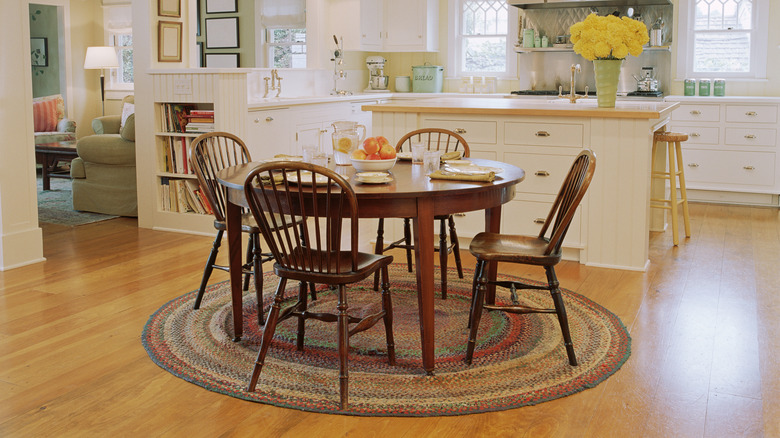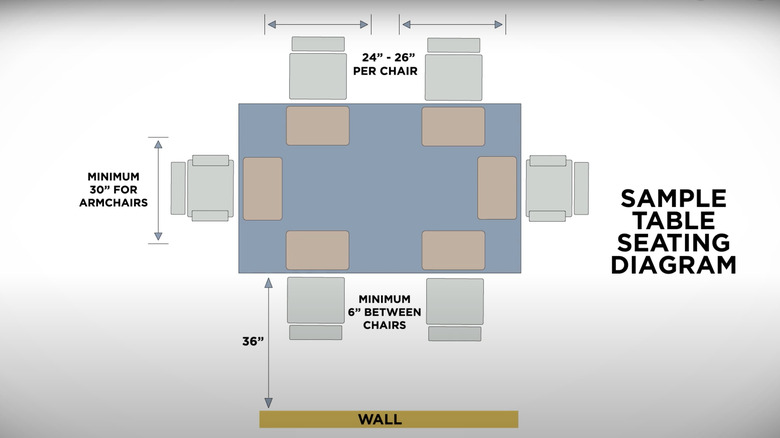Round Or Rectangle: Which Dining Room Table Shape Is Right For You?
The dining table is a hub of your home, the surface on which you gather for family meals and host dinner parties with friends. Every dining space is different, whether it is a long, spacious formal dining room or a compact eat-in kitchen nook. So, when it comes to buying the right dining table for your home, selecting one with a shape ideally suited to your space is essential for both aesthetics and function.
As an interior designer, I am here to tell you that the key to determining the right shape is to actually start with the maximum table size, and to then figure out the best shape from there. Simply measure your space and deduct the necessary clearances to determine the usable space available for your dining table. Based on those measurements, and how many people you would like to seat regularly — so consider not just every child, but how often you host guests, and what number of them — you will know if you should be looking for a round or rectangle table.
Now, let's get your tape measure (and maybe some graph paper) ready, as a few simple dimensions will guide you toward your perfect dining table shape.
Measuring your room to determine the usable space for your dining table
The ideal dining room table shape for your space is determined by the dimensions and shape of the room. You need a minimum clearance of 36 inches or three feet from the edge of a table to the wall, built-in elements, or furniture (don't forget to account for your sideboard or hutch if you have one). This allows the chairs to be fully pulled out and for someone to walk behind the chairs or serve food while someone else is seated. Therefore, to calculate the maximum footprint your table can take up, measure the length and width of the space and subtract three feet of clearance from each wall or element to calculate the usable space available for your table. For example, in a room that is 12 feet long by nine feet deep, your usable space (and therefore maximum dining table measurements) would be six feet long by three feet deep.
For rooms that are irregularly shaped, it is easiest to draw your room to scale on graph paper to see the shape created by coming three feet off of each room element to determine the usable area. Areas open to other rooms have a little more wiggle room, but you will want to take your measurement off of the edge of the walkway between spaces, leaving plenty of room to pass through. You will also want to plan a bit of extra clearance where the table is adjacent to a major traffic area, such as between a dining table and kitchen island (especially with barstools), opting for closer to four or five feet from table to island to keep things more open.
Using the maximum usable space to determine table shape and size
Once you've determined your maximum usable footprint, the ideal table shape will become clear.
If the usable space is more oblong, such as in the six by three feet example, a rectangle would be your pick (or oval for a bit of extra clearance). Round tables do not fit well in narrow spaces. On the contrary, a room with a usable space closer to a square would host a round table beautifully (or square, if you want a little more elbow room). Rectangular tables can be used in square rooms, but you could end up with a lot of extra walking around room on two sides, so opt one that is extra deep to eat up more square footage and stay in scale with the room.
The other thing to consider when finalizing table shape is how many people you would like to seat in the space. Each person needs a minimum of 24 inches wide to be comfortably seated, though closer to 30 inches is ideal, especially to maintain enough distance between dining chairs that are larger in scale. In an example room with a usable space of 8x8 feet, you could use an 8x4 foot rectangular table or one that is eight feet round. Using the per person measurements, the eight-foot round table would easily seat 10 to 12, while the 8x4 table would only seat 8 to 10. In this case, a round table better maximizes the room's square footage and seats two additional people. The next time you are in the market for a new dining table, rely on these usable space and seating calculations to verify the table shape and size best-suited for your particular space.


